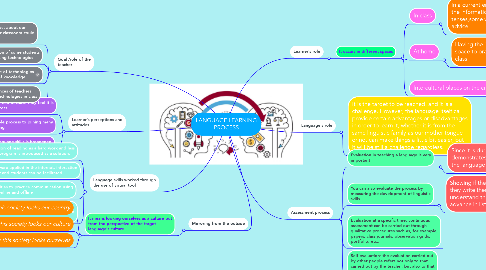
1. Learner’s perceptions and attitudes
1.1. Many second learners do not like to read because they feel it is a laborious and time-consuming process
1.2. The students do not favour the whole process to joining many words together and creating meaning
1.3. Students show that the understanding of language skills is broadened
2. Goal /role of the teacher
2.1. To use technologies could give us more resources to reflect about our teaching process researching by using technologies in our classroom could help us to create new strategies to teach
2.2. To know the perception of some students when they learn by using technologies
2.3. To promote the use of technologies in different fields of knowledge
2.4. To relate some experiences of teachers when they have used technologies in class
3. Language skills worked through the use of virtual tool
3.1. To avoid the perception of reading as a hard work and less dinamic the reading program is introduced as a solution.
3.2. With the recent development of software applied in the internet, interaction among students and between teacher and students can be facilitated
3.3. Students have the opportunities to practice communication using the language learned both online and offline
3.4. The teaching of a second language through the use of technologies allows students to evolve in the cognitive, work, and personal competences required by real-life performance
4. Mirroring from the outside
4.1. It means looking ourselves as a culture but from the perspective of the target language's culture.
4.1.1. How this society looks our country
4.1.2. How this society looks our culture
4.1.3. How this society looks ourselves
5. Learner’s role
5.1. It occurs in different spaces
5.1.1. In class
5.1.1.1. In a current english class where they receive the information of the structure, the tenses,some vocabulary and pronunciation advice.
5.1.2. At home
5.1.2.1. Having the internet, the tv and his or her space to practice what he or she learnt in class
5.1.3. Intercultural places on the city
5.1.3.1. It is not that comon,but it is growng more and more, and it is still an option for learners to have a real contact with natives of the target language.
6. Language’s role
6.1. It is the target to be reached, and it is a challenge. However, the language itself ca provide certain advantages or disadvantages in order to learn it, whether it is from the same linguistic family as our mother tongue or not can make things a little bit easier, but it will be still a challenge regardless.
7. Assessment process
7.1. Evaluation in teaching a language is very important
7.1.1. Since it is during the process that the teacher demonstrates the true understanding and structuring of the language in the student's mind
7.2. You can also evaluate the process by measuring the development of linguistic skills
7.2.1. Showing if they connect and speak well the ideas they think, if they write them with the correct use of the language, also if they understand the instructions of the teacher in English is an advance in listen out

